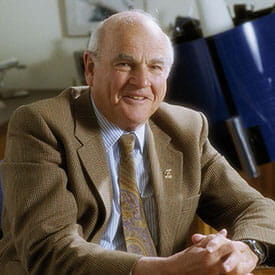Major LIMR Milestones

Philadelphia chromosome heralds new era of genetic research in cancer
The Lankenau Institute for Medical Research’s (LIMR) greatest contribution to the world of biomedical science came in 1960 with the discovery of the first genetic abnormality in cancer, a defect found in most patients with chronic myelogenous leukemia (CML). This discovery heralded the genetics revolution in cancer that is today the mainstream of cancer research.
David Hungerford, a researcher with the Lankenau Hospital Research Institute (known today as LIMR) working in collaboration with Peter C. Nowell, noticed the abnormality in cultured blood cells taken from two patients with CML.
Typical cells each contain 23 pairs of chromosomes that are made of DNA. The Philadelphia chromosome forms when chromosome 9 and chromosome 22 break and exchange parts and can lead to CML. The chromosome was named after the city where the research was conducted.

LIMR’s Nobel Prize winner
During the 1960s, geneticist Baruch Blumberg discovered the hepatitis B virus, showed it can cause liver cancer, and developed a blood test to detect it—work for which he was awarded the Nobel Prize in physiology or medicine in 1976.
Blumberg’s work at the Institute of Cancer Research (ICR), part of LHRI, with Harvey J. Alter resulted in the discovery of the Australia antigen. The researchers observed the antigen in the blood from an Australian aborigine. The protein was identified in 1967 as a surface antigen of hepatitis B virus, the most severe form of the disease. His work formed the basis for the 1982 development of a life-saving vaccine using the antigen.
Other milestones
- With funds donated by Rodman Wanamaker, son of famed retailer John Wanamaker, Lankenau Hospital Research Institute (LHRI) was founded in 1927, with pioneering cancer researcher Dr. Stanley Reimann at the helm.
- In 1952, the very first grant issued by the then-new National Science Foundation was awarded to internationally renowned LHRI researcher Sidney Weinhouse, a pioneer of cancer metabolism who debunked the influential but incorrect early hypothesis that cancer was caused by aberrant glucose metabolism.
- In the 1950s, LHRI researchers Robert Briggs and Thomas King conducted the first successful transplantation of a nucleus from one cell to another, enabling the creation elsewhere of the first cloned animal, the sheep Dolly, and development of clinical methods used for in vitro fertilization in humans. This founding research enabled later work by others that was awarded a Nobel Prize in medicine or physiology.
- Among the many women who contributed to LHRI research, Beatrice Mintz developed in the 1960s the first mammal composed of genetically different cell populations, a breakthrough that led to the creation of the first transgenic species now widely used in research and agriculture.
- During the 1960s, geneticist Baruch Blumberg discovered the hepatitis B virus, showed it can cause liver cancer, and developed a blood test to detect it—work for which he was awarded the Nobel Prize in physiology or medicine in 1976.
- In strengthening its scientific base, a new research building was constructed on Lankenau's campus in 1992 — now the home of LIMR.
- Since 2000, LIMR researchers have helped launch the modern era of immunotherapy treatments for cancer with the discovery and development of a new class of drugs called IDO inhibitors.
- LIMR researchers created nanotechnologies for a precision medicine approach to tumor treatment, and they discovered revolutionary new therapeutic principles that offer the promise to treat autoimmune diseases together as a class.
- Charles Antzelevitch, PhD, Distinguished Professor Emeritus at LIMR, received the prestigious Lifetime Achievement Award from the American College of Cardiology in 2020 for his groundbreaking research on abnormal heart rhythms.
